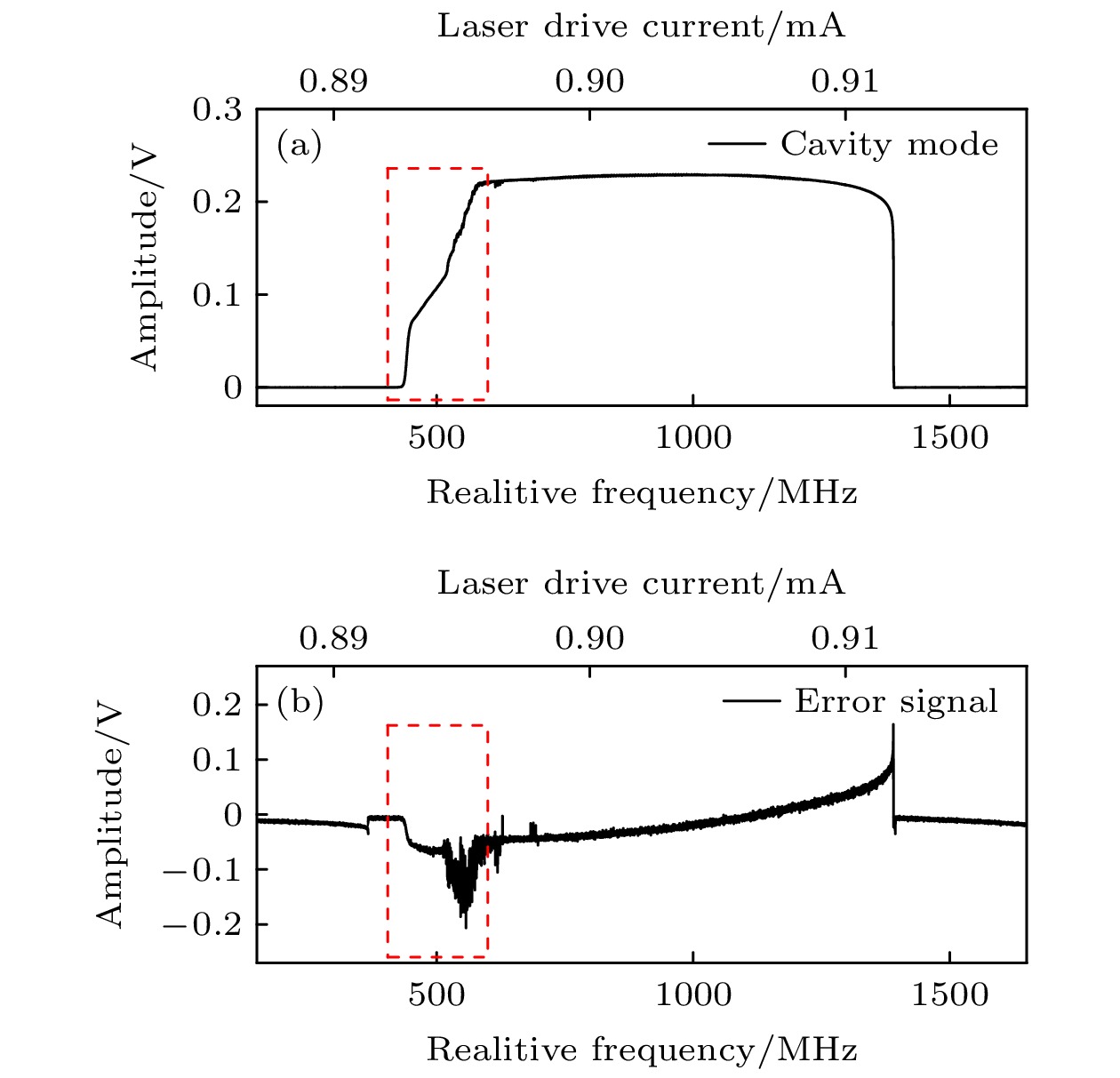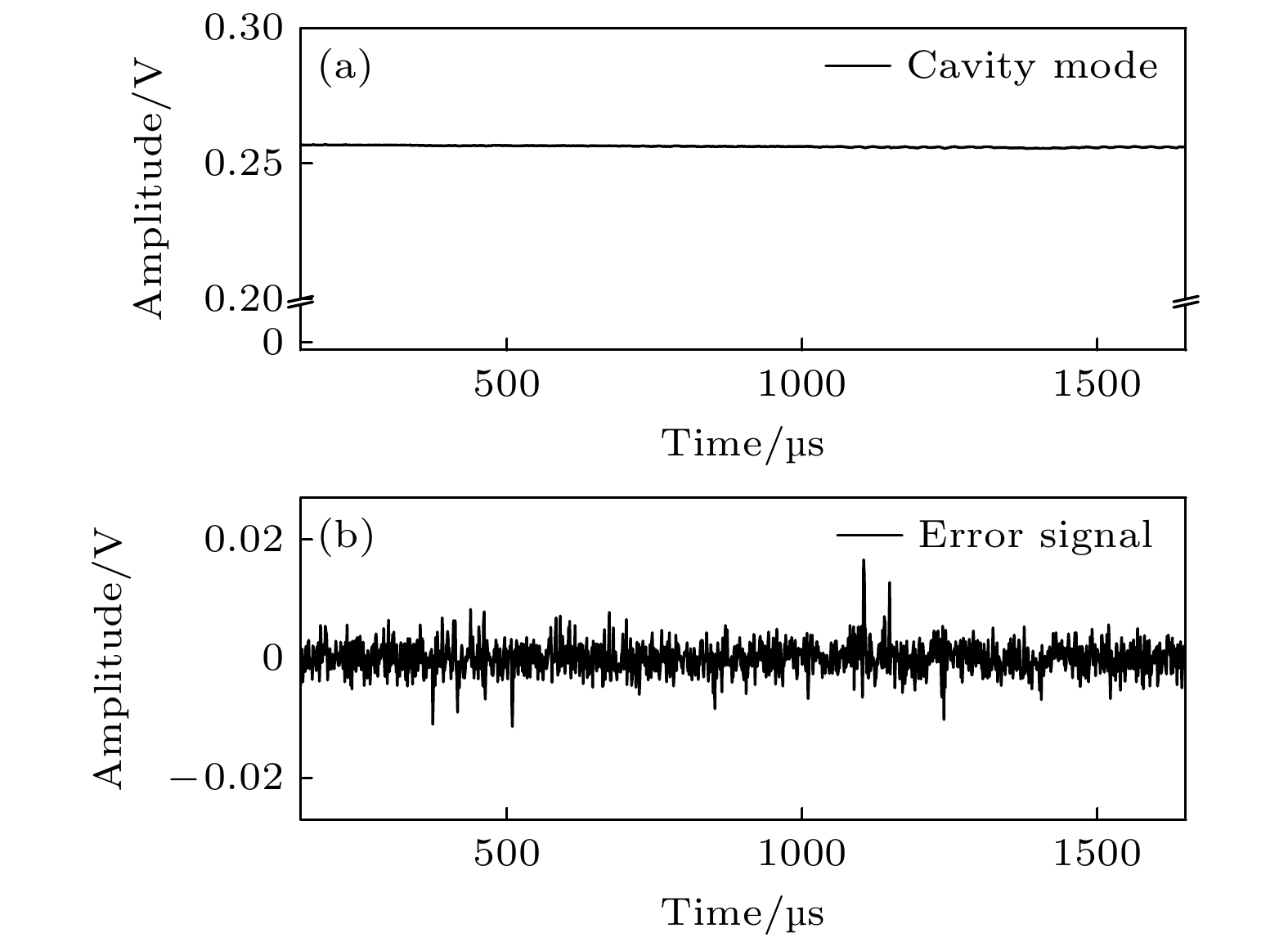-
中红外精密激光光谱技术在痕量气体检测、基本物理常数测定等领域都有重要应用, 然而由于缺乏窄线宽、稳定的中红外光源, 很难实现中红外精密光谱测量. 本文介绍了一种基于光学反馈频率锁定的窄线宽稳定中红外激光产生技术, 分析了光学反馈实现激光到F-P腔锁定的可行性, 利用一个高精细度中红外超稳F-P腔作为频率参考, 基于光学反馈技术实现了量子级联激光器到该超稳腔的锁定. 经过评估得到激光器线宽被压窄到1.1 Hz, 压窄激光线宽的同时稳定了激光频率, 将激光器的长期漂移控制在20 kHz/12 h. 其中, 为了获取长时间稳定的光学反馈, 基于PDH技术获取了误差信号, 用于对反馈相位的实时伺服控制.Mid-infrared precision spectroscopy has important applications in the fields of trace gas detection and the determination of fundamental physical constants. However, due to the limited commercialization of related technologies, there is a lack of narrow linewidth laser sources or linewidth narrowing approaches in the mid-infrared region, as well as stable mid-infrared frequency standards. The most commercialized and widely used mid-infrared laser source is the quantum cascade laser (QCL). But its free-running linewidth is more than MHz scale due to the influence of laser drive current noise and temperature fluctuation. This impedes the development of precision spectroscopy in this region. In this work, we introduce a technique for generating a narrow linewidth, stable mid-infrared laser by using optical feedback frequency locking, with a high-finesse mid-infrared ultrastable Fabry-Pérot cavity as the frequency reference. The optical cavity consists of two high reflectivity mirrors separated by ultra-low expansion (ULE) material with a low temperature expansion coefficient, and its temperature is precisely controlled. And the cavity is also surrounded in a vaccum cavity made of stainless steel. All these measures ensure the cavity length and its longitudinal mode stability. By using optical feecback, a QCL is locked to the cavity, which stabilizes the laser frequency and narrows the laser linewidth. In order to improve the long-term stability of the optical feedback, an active servo is leveraged to control the feedback phase. The error signal for the servo is obtained by using the method similar to the Pound-Derver-Hall locking. In this work, we first theoretically analyze the feasibility of laser to F-P cavity frequency locking by optical feedback. We propose the laser frequency response model with a linear F-P cavity under optical feedback, and analyze the influence of the direct cavity reflection on the laser frequency. Then the experimental demonstration is conducted. Firstly, we measure the reflectivity of the cavity mirror by using cavity ring-down spectroscopy, resulting in a cavity finesse of 30200 and a cavity mode linewidth of 49.7 kHz. After that, we successfully achieve optical feedback frequency locking, and consecutive cavity transmission is observed. The error signal for the control of the optical feedback phase is used to evaluate the locking performance by converting it into the laser frequency noise. By analyzing the noise spectral density, the QCL linewidth is narrowed to 0.3 Hz on a short timescale (< 10 ms). And the long-term stability is suspected to be dedicated by the temperature variation of the optical cavity, resulting in a laser frequency drift 20 kHz/12 h. The narrow linewidth stabilized mid-infrared laser source obtained with this technique is expected to serve as an effective frequency reference source for mid-infrared precision spectroscopic measurements.
-
Keywords:
- laser frequency locking /
- mid-infrared laser /
- linewidth narrowing /
- optical feedback
[1] Hugi A, Maulini R, Faist J 2010 Semicond. Sci. Technol. 25 083001
 Google Scholar
Google Scholar
[2] Faist J, Capasso F, Sivco D L, Sirtori C, Hutchinson A L, Cho A Y 1994 Science 264 553
 Google Scholar
Google Scholar
[3] Argence B, Chanteau B, Lopez O, Nicolodi D, Abgrall M, Chardonnet C, Daussy C, Darquié B, Le Coq Y, Amy-Klein A 2015 Nat. Photon. 9 456
 Google Scholar
Google Scholar
[4] Pound R V 1946 Rev. Sci. Instrum. 17 490
 Google Scholar
Google Scholar
[5] Drever R W P, Hall J L, Kowalski F V, Hough J, Ford G M, Munley A J, Ward H 1983 Appl. Phys. B 31 97
 Google Scholar
Google Scholar
[6] Shi X, Zhang J, Zeng X, Lü X, Liu K, Xi J, Ye Y, Lu Z 2018 Appl. Phys. B 124 153
 Google Scholar
Google Scholar
[7] Qiao C, Tan C Z, Hu F C, Couturier L, Nosske I, Chen P, Jiang Y H, Zhu B, Weidemüller M 2019 Appl. Phys. B 125 215
 Google Scholar
Google Scholar
[8] Taubman M S, Myers T L, Cannon B D, Williams R M, Capasso F, Gmachl C, Sivco D L, Cho A Y 2002 Opt. Lett. 27 2164
 Google Scholar
Google Scholar
[9] Weidmann D, Smith K, Ellison B 2007 Appl. Opt. 46 947
 Google Scholar
Google Scholar
[10] Maisons G, Carbajo P G, Carras M, Romanini D 2010 Opt. Lett. 35 3607
 Google Scholar
Google Scholar
[11] Zhao B, Wang X, Wang C 2020 ACS Photonics 7 1255
 Google Scholar
Google Scholar
[12] Gagliardi G, Loock H P 2014 Cavity-Enhanced Spectroscopy and Sensing (Heidelberg: Springer) pp163–183
[13] Tian J, Zhao G, Fleisher A J, Ma W, Jia S 2021 Opt. Express 29 26831
 Google Scholar
Google Scholar
[14] Dahmani B, Hollberg L, Drullinger R 1987 Opt. Lett. 12 876
 Google Scholar
Google Scholar
[15] Laurent P, Clairon A, Breant C 1989 IEEE J. Quantum Electron. 25 1131
 Google Scholar
Google Scholar
[16] Hemmerich A, McIntyre D H, Schropp D, Meschede D, Hänsch T W 1990 Opt. Commun. 75 118
 Google Scholar
Google Scholar
[17] Fasci E, Coluccelli N, Cassinerio M, Gambetta A, Hilico L, Gianfrani L, Laporta P, Castrillo A, Galzerano G 2014 Opt. Lett. 39 4946
 Google Scholar
Google Scholar
[18] Zhao G, Tian J, Hodges J T, Fleisher A J 2021 Opt. Lett. 46 3057
 Google Scholar
Google Scholar
[19] Morville J, Kassi S, Chenevier M, Romanini D 2005 Appl. Phys. B 80 1027
 Google Scholar
Google Scholar
[20] Kessler T, Legero T, Sterr U 2012 J. Opt. Soc. Am. B 29 178
 Google Scholar
Google Scholar
[21] Nazarova T, Riehle F, Sterr U 2006 Appl. Phys. B 83 531
 Google Scholar
Google Scholar
[22] Zhao G, Bailey D M, Fleisher A J, Hodges J T, Lehmann K K 2020 Phys. Rev. A 101 062509
 Google Scholar
Google Scholar
[23] Kikuchi K 2012 Opt. Express 20 5291
 Google Scholar
Google Scholar
-
-
[1] Hugi A, Maulini R, Faist J 2010 Semicond. Sci. Technol. 25 083001
 Google Scholar
Google Scholar
[2] Faist J, Capasso F, Sivco D L, Sirtori C, Hutchinson A L, Cho A Y 1994 Science 264 553
 Google Scholar
Google Scholar
[3] Argence B, Chanteau B, Lopez O, Nicolodi D, Abgrall M, Chardonnet C, Daussy C, Darquié B, Le Coq Y, Amy-Klein A 2015 Nat. Photon. 9 456
 Google Scholar
Google Scholar
[4] Pound R V 1946 Rev. Sci. Instrum. 17 490
 Google Scholar
Google Scholar
[5] Drever R W P, Hall J L, Kowalski F V, Hough J, Ford G M, Munley A J, Ward H 1983 Appl. Phys. B 31 97
 Google Scholar
Google Scholar
[6] Shi X, Zhang J, Zeng X, Lü X, Liu K, Xi J, Ye Y, Lu Z 2018 Appl. Phys. B 124 153
 Google Scholar
Google Scholar
[7] Qiao C, Tan C Z, Hu F C, Couturier L, Nosske I, Chen P, Jiang Y H, Zhu B, Weidemüller M 2019 Appl. Phys. B 125 215
 Google Scholar
Google Scholar
[8] Taubman M S, Myers T L, Cannon B D, Williams R M, Capasso F, Gmachl C, Sivco D L, Cho A Y 2002 Opt. Lett. 27 2164
 Google Scholar
Google Scholar
[9] Weidmann D, Smith K, Ellison B 2007 Appl. Opt. 46 947
 Google Scholar
Google Scholar
[10] Maisons G, Carbajo P G, Carras M, Romanini D 2010 Opt. Lett. 35 3607
 Google Scholar
Google Scholar
[11] Zhao B, Wang X, Wang C 2020 ACS Photonics 7 1255
 Google Scholar
Google Scholar
[12] Gagliardi G, Loock H P 2014 Cavity-Enhanced Spectroscopy and Sensing (Heidelberg: Springer) pp163–183
[13] Tian J, Zhao G, Fleisher A J, Ma W, Jia S 2021 Opt. Express 29 26831
 Google Scholar
Google Scholar
[14] Dahmani B, Hollberg L, Drullinger R 1987 Opt. Lett. 12 876
 Google Scholar
Google Scholar
[15] Laurent P, Clairon A, Breant C 1989 IEEE J. Quantum Electron. 25 1131
 Google Scholar
Google Scholar
[16] Hemmerich A, McIntyre D H, Schropp D, Meschede D, Hänsch T W 1990 Opt. Commun. 75 118
 Google Scholar
Google Scholar
[17] Fasci E, Coluccelli N, Cassinerio M, Gambetta A, Hilico L, Gianfrani L, Laporta P, Castrillo A, Galzerano G 2014 Opt. Lett. 39 4946
 Google Scholar
Google Scholar
[18] Zhao G, Tian J, Hodges J T, Fleisher A J 2021 Opt. Lett. 46 3057
 Google Scholar
Google Scholar
[19] Morville J, Kassi S, Chenevier M, Romanini D 2005 Appl. Phys. B 80 1027
 Google Scholar
Google Scholar
[20] Kessler T, Legero T, Sterr U 2012 J. Opt. Soc. Am. B 29 178
 Google Scholar
Google Scholar
[21] Nazarova T, Riehle F, Sterr U 2006 Appl. Phys. B 83 531
 Google Scholar
Google Scholar
[22] Zhao G, Bailey D M, Fleisher A J, Hodges J T, Lehmann K K 2020 Phys. Rev. A 101 062509
 Google Scholar
Google Scholar
[23] Kikuchi K 2012 Opt. Express 20 5291
 Google Scholar
Google Scholar
计量
- 文章访问数: 5301
- PDF下载量: 133
- 被引次数: 0














 下载:
下载:







